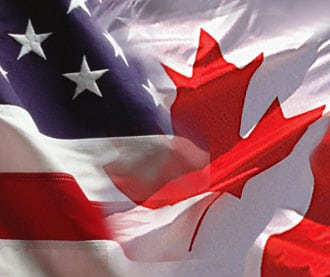Canada’s National Round Table on the Environment and the Economy (NRTEE), a panel composed mainly of government appointees from industry and former Conservative politicians, has released a new report assessing whether Canada should “lead, lag, or harmonize” climate policies with the US, and the consequences of doing so.
In recent years, the Canadian federal government has opposed unilaterally acting on climate change, instead committing to harmonize greenhouse gas (GHG) reductions with the US in a continental approach. This has been a favourite position for Canadian Environmental Ministers wishing to postpone acting on climate change for fear of locking Canada into GHG emissions reductions, and notably for Jim Prentice who quit as Environment Minister late last year:
“Our determination to harmonize our climate change policy with that of the United States also extends beyond greenhouse gas emission targets: we need to proceed even further in aligning our regulations.”
“We will only adopt a cap-and-trade regime if the United States signals that it wants to do the same. Our position on harmonization applies equally to regulation…Canada can go down either road — cap-and-trade or regulation — but we will go down neither road alone.”
This report is timely in that only a month ago, on January 2nd, 2011, the US Environmental Protection Agency (EPA) began issuing permits for GHG emissions from large stationary sources to reduce global warming pollution from fossil fueled power plants and oil refineries. In spite of growing pressure for the government to honour its longstanding position on Canada-US climate policy harmonization, the Conservative government has yet to take any action (though Bill C-311, climate legislation which had passed the lower house was defeated in a poorly attended last-minute vote by the unelected Senate in November) and new Canadian Environmental Minister John Baird is at best dragging his feet, and at worst backtracking.
In its recommendations, the NRTEE says that, regardless of US policy, Canada should address climate change in order to avoid delaying GHG emissions reductions and maintain economic competitiveness. According to Bob Page, NRTEE Chair, Canada has a duty to act and meet its national responsibilities:
“We need to understand how we can meet our environmental responsibilities as a sovereign state and a global actor fully comprehending the unique economic ties we enjoy on this continent.”
Given time and more certainty from the US, a Transitional Policy approach could effectively harmonize climate policies between the two countries, according to the following elements:
1. Contingent Carbon Pricing – to establish a price collar that limits the Canadian carbon price to no more than $30.00/tonne CO2 higher than the price in the US
2. A National Cap-and-Trade System – with auctioning of permits and revenue recycling to cap emissions and address regional and sectoral concerns
3. Limited International Permits and Domestic Offsets – to keep domestic carbon prices lower for Canadian firms
4. Technology Fund – to stimulate investment in needed emission reductions technologies
This is the third of seven reports in the NRTEE Climate Prosperity series studying the economic risks and opportunities of climate change policy options for Canada. Four more will be released throughout 2011.
Subscribe to our newsletter
Stay up to date with DeSmog news and alerts






